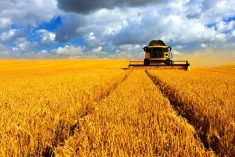Three generations ago Canadian farmers got their market information from the local elevator and their weekly farm paper. A generation on, they shushed the kids and strained to hear the markets on the CBC’s noon-hour farm report. Then just one generation ago, a handful took the electronic plunge and bought a DTN system that gave them the same satellite-based market reports as their local elevators.
But that’s all history now. Today farmers can simply slip their BlackBerry out of its holster, thumb a couple of buttons and instantly be looking at live quotes from the commodities markets, or special reports from a marketing service.
Read Also

The big squeeze: How to be fair to siblings during farm succession
Managing sibling business relationships on family farms.
It’s what Yellowgrass, Sask. grain farmer Jeff Watson does every day. Or, more accurately, it’s what he does several times every hour.
“I use it all day, every day,” Watson says with a laugh while talking to Country Guide and taking a break from assembling a new air seeder. “It’s how I get all of my futures quotes and how I do all my communications with my commodity broker, using texts or email.”
Watson has been using a smartphone for about two years now, after he picked one up when the contract for his last phone expired. That makes him an early adopter by pretty much any standard, and in farming it makes him a genuine pioneer.
After a couple of seasons using the technology, he’s also become a bit of an advocate, telling the producer groups he’s involved with and the companies he does business with that it’s just a matter of time before smartphones are recognized as the most reliable — and convenient — way to get information out to today’s young farmer.
“These companies and organizations are all wondering how they can reach the young farmer of tomorrow, and how they can get information out to them,” Watson says. “I tell them, ‘It’s going to be through their smartphones, guys.’”
So, what exactly is a smartphone? Well, to start with, it’s not really a phone. Oh, sure, you can make a call on it, that much is true. But calling it a phone is like calling your computer a typewriter. You can type on one, but it can do so much more.
Bill Smith, a technology specialist with Ag-Chieve, a Winnipeg-based commodity marketing advisory service, says smartphones are really a breakthrough when it comes to making the power of computing not only mobile, but always connected to a network. For farmers and other people who don’t work in offices that are hard-wired for data transmission, that’s a quantum leap forward.
“They’re really a hand-held mobile computer that happens to have the ability to make a voice call,” explains Smith. “But they can also send and receive email, text messages and data of all types, and perform computing too.”
Sam Vurrabindi is another tech specialist who sees great promise for smartphones on farms. He’s the former head of information technology for Syngenta Canada and currently an entrepreneur who works on IT issues for various industries, including agriculture.
Lately he’s partnered up with former colleague Warren Libby, who used to head Syngenta’s Canadian division. They’re working on a company called Savvy Farmer, a subcription service which offers access to a website that acts as a crop protection resource. It allows farmers to compare their control options, look at prices, find generic alternatives and generally manage their crop protection programs.
Savvy Farmer tracks all of the available control options in a fast-changing marketplace where there are more and more generic products.
Libby says it needs to be updated constantly. “To give you as sense how much data we’re talking about, in just the past two months, there have been 138 separate regulatory changes out of Ottawa.”
Recently Libby and Vurrabindi have been working on their first smartphone apps, and they took the time to talk to COUNTRY GUIDE from their offices in Guelph, Ont. Vurrabindi says a big part of the exercise has been determining what fits best in an app and what should be kept on the full-function website intended for desktops and laptops.
“There are certain things that make a lot of sense — for example we have weed and pest photos to aid farmers in identification — to put on an app,” Vurrabindi says. “They’ll show up quite clearly on the smaller smartphone screen. But there are other things — a full product MSDS and label, for example — that don’t make sense because there’s just too much information to try to read on a BlackBerry or iPhone.”
“What we are finding is that there is a lot of interest in having those things that they’d use in the field on a mobile app,” Vurrabindi says.
Ag-Chieve’s Smith agrees that finding the right format to deliver information to a smartphone is going to be key to succeeding. That company has been experimenting with a Twitter-like delivery mechanism for short 140-character text messages that are pushed out to the phones of subscribers, based on what sort of market topics the individual farmer has indicated they follow.
“We’re able to take something like a 10-minute video or multi-page report and boil it down to the absolute essence, and send it out directly to farmers,” Smith says. “Farmers are telling us that they really like the immediacy, the way they can customize it to just the information they need and the fact that they get it without having to log in to anything, or needing to remember a user name or a password.”
One of the most comprehensive market-tracking apps is available at no charge from Farm Business Communications (FBC), the publisher of COUNTRY GUIDE. Editorial
of farmers’ most important primary information needs — timely market information, up-to-the-second weather and news headlines.
The app, now available for BlackBerry and soon available for iPhone, allows farmers to track all major U.S. and Canadian futures contracts with a 15-minute delay. There’s also an alert function.
“If you want to be alerted when a contract reaches or falls below a certain price, you can set it and a notification will be sent to your phone,” Morriss says.
The app also gives on-demand access to audio files of the twice-daily Farm Market News radio broadcasts from Commodity News Service Canada, and provides access to real-time weather information from the 800- plus WeatherFarm stations in Western Canada.
“We believe it’s one of the most comprehensive apps out there and it’s available free of charge for downloading at agreader.ca,” Morriss says.
In Ontario, Grain Farmers of Ontario recently launched its SmartSell app for both BlackBerry and iPhone. Erin Fletcher, GFO’s manager of public affairs and communications, says the app provides futures quotes as well as local cash prices.
“This now lets grain farmers in Ontario compare elevator prices head to head in their region,” says Fletcher.
And surprisingly Fletcher said the real challenge wasn’t finding someone who could design an apps. Instead it was finding a way to get the two separate sources of data — both of which were already readily available — to work together so that the app would update automatically.
“That was a bit of a challenge, but eventually we did find a solution that didn’t cost an arm and a leg — and that was very important because we wanted this to be a free service to our members,” she says.
It does however highlight the technical challenges that developers face when designing smartphone apps. While the numbers — or whatever the data might be — are likely out there, bringing it all together can be easier said than done.
Then there’s the issue of exactly what type of app you’re talking about. They come in three distinct types, says Vurrabindi.
There are stand-alone apps that perform a set function such as calibrating a sprayer or converting imperial measures to metric. They don’t necessarily need a data connection to work.
“They’re basically small programs that are doing mathematics,” Vurrabindi says. “They don’t require regular updating to remain relevant.”
Then there are applications that are managing a larger and more complicated set of data — something that might require updating regularly to remain relevant.
“Here you can either have something that’s a mobile version of the website that’s been optimized for the mobile platform with its smaller screen, which you access with a web browser, or a third type, what’s known as a hybrid,” Vurrabindi says. “This is a software shell that needs an Internet connection to update regularly.”
The smartphone browser-optimized sites are common for newspapers and the updates generally automatically appear in the phone’s browser. The hybrids are small apps that are launched and then connect to the Internet to refresh their data, such as a weather app that you can set to give you a seven-day local forecast.
The complexity of designing for all the different platforms and possibilities can make for a daunting challenge at times, but Vurrabindi says he expects the industry to rapidly standardize, as it has in other segments of the Internet. As that happens information from various sources will begin to work together more readily, unleashing what he sees as the system’s vast potential.
From a farmer perspective Jeff Watson says his smartphone is both tantalizing and a bit frustrating — often at the same time. He tells the story of a demonstration he saw recently of the Freight Rate Manager from the University of Saskatchewan. It uses railway and elevator tarriffs along with grower data to calculate net returns to the farm.
While he was impressed, Watson says he would really be ahead of the game if he could combine it into one app with the commodity market feed he has from another source.
“That would be great, I’d never have to talk to anyone then,” Watson says with a chuckle. “It would be a very powerful marketing tool. You can see what these phones are going to be — but they’re not quite there yet. But I do think that it’s pretty clear that they’ll become more and more important.”
As they do evolve one thing is becoming clear, they’re going to be a crucial tool for the farmer of tomorrow, says Savvy Farmer’s Warren Libby.
“The market research we’ve seen shows that as farmers are renewing their cellphone contracts, they’re getting smartphones,” Libby says. “At the end of last year 17 per cent of farmers had them and the projection is that by the end of this year, 40 per cent will.”
Ag-Chieve’s Bill Smith agrees that it’s a system that’s developing a critical mass, and that he’s reminded of a time close to 20 years ago, when he was working for the CBC and using a very early version of the Internet.
“I remember showing a CBC vice-president how I could get a sound file from someone in another province, and they couldn’t believe you could do that with a computer,” Smith says. “Five years later, in 1998, we were doing entire four-hour radio programs on our computers and sending them coast to coast on the Internet. Smartphones will evolve just as much and just as quickly.”CG
———
“ I Used It All Day, Every Day.”
— Jeff Watson, Yellowgrass, Sask.















